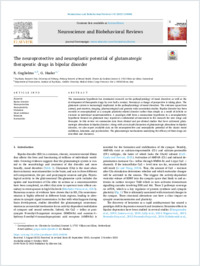The neuroprotective and neuroplastic potential of glutamatergic therapeutic drugs in bipolar disorder
DOKPE
- Guglielmo, Riccardo Catholic University Medical School, Rome, Italy
- Hasler, Gregor ORCID University of Fribourg
- 2022
Published in:
- Neuroscience and Biobehavioral Reviews. - Elsevier BV. - 2022, vol. 142, p. 1-19
English
The monoamine hypothesis has dominated research on the pathophysiology of mood disorders as well as the development of therapeutic drugs by over half a century. Nowadays a change of perspective is taking place. The glutamate system is increasingly implicated in the pathophysiology of mood disorders. The evidence spans from
animal, post-mortem, imaging, pharmacological and genome-wide association studies. Bipolar disorder has been recently re-conceptualized as a synaptic plasticity-related disorder rather than simply as a result of deficits or excesses in individual neurotransmitters. A paradigm shift from a monoamine hypothesis to a neuroplasticity hypothesis focused on glutamate may represent a substantial advancement in the research for new drugs and therapies. In this review we summarize data from clinical and pre-clinical studies that have addressed glutamatergic alterations in bipolar disorder. Along with an in-depth discussion of glutamatergic alterations in bipolar disorder, we also report available data on the neuroprotective and neuroplastic potential of the classic mood stabilizers, ketamine, and psychedelics. The glutamatergic mechanisms underlying the efficacy of these drugs are described and discussed.
animal, post-mortem, imaging, pharmacological and genome-wide association studies. Bipolar disorder has been recently re-conceptualized as a synaptic plasticity-related disorder rather than simply as a result of deficits or excesses in individual neurotransmitters. A paradigm shift from a monoamine hypothesis to a neuroplasticity hypothesis focused on glutamate may represent a substantial advancement in the research for new drugs and therapies. In this review we summarize data from clinical and pre-clinical studies that have addressed glutamatergic alterations in bipolar disorder. Along with an in-depth discussion of glutamatergic alterations in bipolar disorder, we also report available data on the neuroprotective and neuroplastic potential of the classic mood stabilizers, ketamine, and psychedelics. The glutamatergic mechanisms underlying the efficacy of these drugs are described and discussed.
- Faculty
- Faculté des sciences et de médecine
- Department
- Master en médecine
- Language
-
- English
- Classification
- Pathology, clinical medicine
- License
-
Rights reserved
- Open access status
- green
- Identifiers
-
- DOI 10.1016/j.neubiorev.2022.104906
- ISSN 0149-7634
- Persistent URL
- https://folia.unifr.ch/unifr/documents/327252
Statistics
Document views: 79
File downloads:
- guglielmohasler2022: 297
